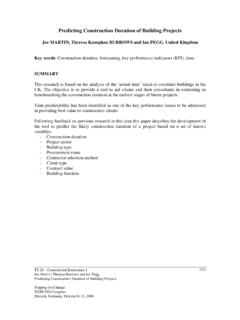Transcription of General Practice – Developing confidence, capability and ...
1 General Practice Developing confidence, capability and capacity A ten point action plan for General Practice NursingContentsDeveloping General Practice Nursing in England, Professor Jane Cummings, Chief Nursing Officer, England Introduction Ten point action plan Implementing the GPN Ten Point Action Plan Early key milestones Resources4 8 10 12 2223 NHS England Publications Gateway Reference number: 06870 General Practice is the largest branch of healthcare and is admired around the world. Its strength lies in the personal care delivered to a registered list of patients. In recent years a growing and ageing population with multiple complex health conditions has led to increased pressure on the General Practice workforce, making it difficult to improve care while causing frustration to people accessing services and to order to address these issues and to support General Practice to deliver the Five Year Forward View, NHS England launched the General Practice Forward View (GPFV) in April 2016.
2 It pledged to increase investment, improve infrastructure and redesign care. In addition, it included a crucial pledge to significantly expand the entire General Practice workforce. This Ten Point Action Plan for General Practice Nursing, describes the nursing element of the GPFV. This helps nurses and health care support workers (HCSW) focus on demonstrating their contribution to reducing the three gaps identified in the Five Year Forward View - the health and well-being gap, the care and quality gap, and the funding and efficiency gap. Subsequently, the Next Steps on The Five year Forward View sets out how we will recruit and train the workforce needed to meet the challenges ahead. This will mean more convenient access to care, and a stronger focus on population health and prevention.
3 There will be more GPs and a wider range of Practice staff will operate in more modern buildings. In addition there will be better integration with community and preventive services, hospital specialists and mental health care. The plan will also provide a useful framework for Sustainability and Transformation Partnerships (STPs) to build upon when Developing their local workforce Practice Nursing (GPN) teams are a key component of the General Practice workforce. They provide care and treatment across the life course and increasingly work in partnership with people with acute illness and with complex undifferentiated member of the nursing team, from the health care support worker to the nursing associate, Practice nurse, specialist nurse and advanced clinical practitioner, has a vital role in delivering care.
4 They also have a responsibility to lead change and add value so that improved outcomes, a better patient experience and more effective and efficient use of resources can be achieved. GPNs work with their GP colleagues, clinical pharmacists, mental health therapists, physician associates, other allied health professionals, Practice managers and receptionists, as part of the extended primary care team. However, like their GP colleagues, GPNs are under pressure from the rising demand for primary care fuelled by the ageing population, the increase in long term conditions and the drive to shift the provision of care into community settings. In addition, GPNs are facing workforce pressures of their own. A recent survey of 3,426 registered nurses working in General Practice by the Queens Nursing Institute (QNI) General Practice Nursing in the 21st Century (2016) corroborated by the Ipsos MORI Research; The recruitment, retention and return of nurses to General Practice nursing in England (2017) revealed that a third expressed an intention to retire by 2020.
5 If this figure is extrapolated to the 23,100 headcount of GPNs nationally (NHS Digital, Sept 2016) it would imply that over 8,000 may leave the workforce in the next three is clear, then, that we face very considerable challenges recruiting and retaining a workforce that is fit for the future. We must develop health and care services that have the resilience to cope with the changing landscape, demographic pressures and rising demand. We cannot and should not rely on traditional solutions we must think differently. We expect more GPNs to have a role in leading practices or social enterprises and the opportunity to think differently about ways to improve access and outcomes. We need to do more to ensure individuals, their families and communities have access to high quality services, wherever they live.
6 Most importantly, we need to get serious about prevention. GPNs are in an ideal position to take the lead in bringing about the behaviour change. Evidence shows this can reduce obesity, heart disease, cancer and diabetes, improve health and fitness, and save General Practice Nursing in EnglandProfessor Jane Cummings Chief Nursing Officer for EnglandImage courtesy of Woman and Home45A ten point action plan for General Practice NursingGeneral Practice Developing confidence, capability and capacity This GPN Ten Point Action Plan outlines the work we will undertake nationally and in partnership with other organisations to address the challenges look forward to working with GPNs, their Practice teams and GP colleagues as we implement this plan, which I believe.
7 Will ensure that the potential of the current and future GPN workforce is fully realised in the coming are already many GPNs who demonstrate that they have the confidence, capability and capacity to deliver services differently. They are leading the way by offering services across the new care models and federations of practices, organising group consultations, using digital solutions, engaging in social prescribing and helping with care navigation. We need to build and retain this skilled and adaptable workforce capable of responding to a changing world while attracting new recruits to the profession by ensuring that General Practice nursing offers a strong career pathway to high calibre nursing staff.
8 The District Nursing and General Practice Nursing Education and Career Framework published by HEE in October 2015 describes how practitioners can plan and develop their career, moving from a newly qualified Practice nurse, to someone with advanced skills to advanced clinical Practice . Promoting this career pathway will help improve access to training, skills development, leadership opportunities and professional support which will help deliver on the goals set out in the GPFV and the Triple Aim outcomes in Leading Change, Adding Value (LCAV). This framework for nursing, midwifery and care staff, published in May 2016, is designed to enable nurses to deliver better outcomes, better experiences for patients and make better use of resources, whilst reducing variation in standards of care that cannot be justified by reasons of geography, demography or infrastructure.
9 The work of GPNs encompasses all ten commitments in the LCAV report and the LCAV website shows examples of where this is happening. 67A ten point action plan for General Practice NursingGeneral Practice Developing confidence, capability and capacity The GPFV published in April 2016 pledged a major expansion of the primary care workforce which includes GPNs. In addition in March 2017, HEE published General Practice Nursing Workforce Development Plan Recognise, Rethink and Reform. This included a series of recommendations for organisations that can influence the General Practice nursing workforce. General Practice Developing confidence, capability and capacity: a ten point action plan for General Practice Nursing responds to both these documents supported by the 15 million investment described in the GPFV.
10 It is designed to provide a highly-skilled GPN workforce that includes both registered nurses and non-registered HCSWs. The plan is aimed at, raising the profile of General Practice nursing as a first destination career improving access to training increasing the number of pre-registration nurse placements and enhancing retention supporting return to work schemes for Practice nurses and Developing a career pathway for GPNs and HCSWs. This GPN Ten Point Action Plan describes the actions needed as part of expanding the capacity and capability across the whole primary care workforce. This will enable us to manage more people s health closer to home. It will also build GPN capability to support improved and innovative approaches to delivering health and wellbeing.















